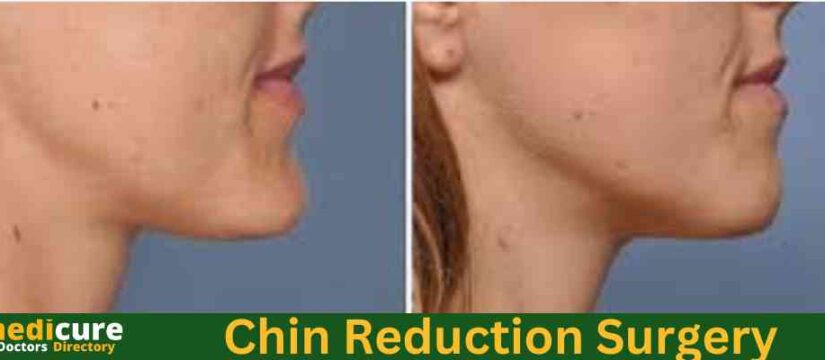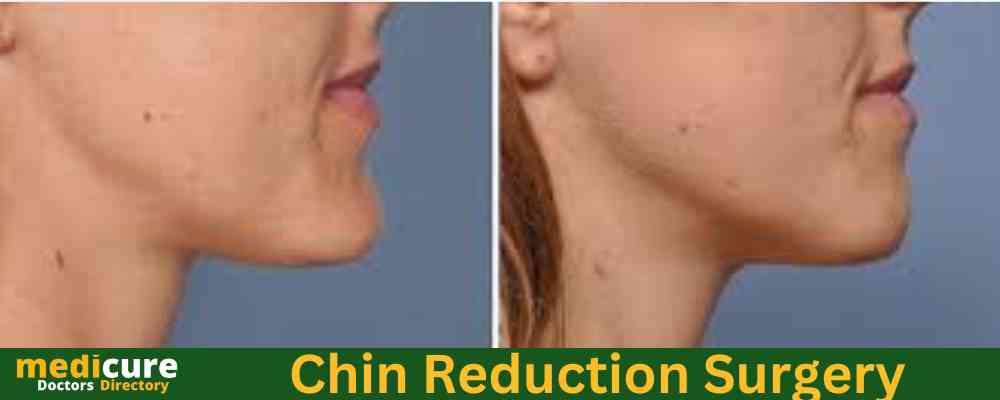MediCure

Chin reduction surgery, also known as chin surgery genioplasty or mentoplasty, is a cosmetic surgical procedure that aims to improve the appearance of a person’s chin by reducing its size or altering its shape. This procedure is typically performed by a plastic surgeon and can be done under local or general anesthesia.
What is chin reduction surgery?
During the surgery, the surgeon will make incisions inside the mouth or under the chin to access the bone and/or tissue of the chin. They may then use techniques such as shaving down the bone or removing excess tissue to achieve the desired reduction in size or change in shape.
The surgeon will then reposition the chin and close the incisions using sutures.
The recovery time for chin reduction surgery typically lasts several weeks, during which time the patient may experience swelling and bruising. Torment drug might be prescribed to manage any discomfort.
It is important to follow the surgeon’s post-operative instructions carefully to ensure proper healing and limit the gamble of inconveniences.
It’s worth noting that like all surgical procedures, there are risks associated with chin reduction surgery, including infection, bleeding, and nerve damage. It is important to have a thorough consultation with a qualified and experienced plastic surgeon to discuss the potential risks and benefits of the procedure before deciding to undergo surgery.
Who gets chin axing surgery?
Chin reduction surgery, also known as genioplasty or mentoplasty, is a cosmetic surgical procedure that can benefit people who are dissatisfied with the size, shape, or projection of their chin. The procedure is usually performed for aesthetic purposes, although it may also be done to improve the function of the jaw or to correct a congenital or developmental abnormality.
The ideal candidates for chin reduction surgery are individuals who are in good health and have realistic expectations about the results of the procedure. Some common reasons people opt for chin reduction surgery include:
- A prominent or protruding chin that is out of proportion with the rest of the face.
- A chin that is asymmetrical or misaligned with the rest of the facial features.
- Difficulty chewing, speaking, or breathing due to a jaw misalignment or malformation.
- A “double chin” caused by excess fat or skin in the chin and neck area.
- Facial trauma or injury resulting in a misshapen or deformed chin.
- Congenital conditions such as cleft chin or facial asymmetry.
Can chin surgery be combined with other procedures?
Yes, chin reduction surgery can be combined with other cosmetic or reconstructive procedures, depending on the patient’s individual needs and goals. In fact, combining chin reduction surgery with other facial surgeries can often produce a more balanced and harmonious result.
Some of the most common procedures that may be performed in combination with chin reduction surgery include:
- Rhinoplasty:This is a procedure to alter the shape and size of the nose. Chin reduction surgery can be done in conjunction with rhinoplasty to create a more balanced and proportionate appearance.
- Facelift: This is a procedure to lift and tighten the skin on the face and neck. Chin reduction surgery can be performed as part of a facelift to improve the overall balance and symmetry of the face.
- Liposuction: This is a procedure to remove excess fat from areas of the body, including the chin and neck. Liposuction of the chin and neck area can be done in conjunction with chin reduction surgery to create a more defined jawline.
- Dental procedures: In some cases, chin reduction surgery may be combined with orthodontic treatment or other dental procedures to improve the function and appearance of the jaw.
What happens before chin curtailment surgery?
Before chin reduction surgery, you will have a consultation with a qualified and experienced plastic surgeon who will evaluate your individual needs and goals, perform a physical exam, and discuss the potential risks and benefits of the procedure.
During the consultation, you should inform the surgeon of any medical conditions or medications you are taking, as well as any allergies or previous surgeries. You may also be asked to provide a medical history and undergo some medical tests, such as blood tests or imaging studies.
The surgeon will also take photographs of your face and chin from various angles to help plan the procedure and evaluate the results. They may also use computer imaging software to give you an idea of what your chin will look like after the surgery.
Before the surgery, you may be asked to stop smoking, avoid certain medications, and follow a specific diet to help ensure a smooth recovery. You should arrange for someone to drive you home after the surgery and provide help with daily activities for the first few days of recovery.
What happens during chin reduction surgery?
Chin reduction surgery, also known as genioplasty or mentoplasty, is typically performed on an outpatient basis and usually takes about 1 to 2 hours to complete. The specifics of the surgery may vary depending on the patient’s individual needs and goals, but generally the procedure involves the following steps:
1. Anesthesia:
Before the surgery begins, you will be given anesthesia to help you remain comfortable and pain-free. Your surgeon may use local anesthesia with sedation or general anesthesia, depending on your individual needs and preferences.
2. Incisions:
The surgeon will make one or more incisions in the chin area, either inside the mouth or underneath the chin. This allows access to the underlying bone.
3. Reshaping the bone:
The surgeon will then use a bone saw or other surgical instruments to reshape the chin bone. This may involve removing a portion of the bone to reduce the size of the chin or shifting the position of the bone to improve its alignment with the rest of the face.
4. Closing the incisions:
Once the desired changes have been made to the chin, the surgeon will close the incisions with sutures or surgical adhesive. If the incisions were made inside the mouth, there will be no visible scarring.
5. Dressings and recovery:
The surgeon will place dressings or a compression garment on the chin area to reduce swelling and promote healing. You will be monitored in a recovery area until you are fully awake from anesthesia, and then you will be able to go home with a responsible adult who can take care of you for the first few days after surgery.
What happens after chin reduction surgery?
After the surgery, you can expect some swelling, bruising, and discomfort, which can be managed with pain medications and cold compresses. You will need to follow specific instructions for post-operative care, including how to care for the incision site, what to eat, and how to manage pain and swelling. You will have follow-up appointments with your surgeon to monitor your progress and ensure a safe and successful recovery.
What is recovery like after chin reduction surgery?
Recovery after chin reduction surgery will vary depending on the extent of the surgery, your general health, and other individual factors. Here are some general guidelines on what to expect during the recovery period:
1. Swelling and bruising:
Swelling and bruising are common after chin reduction surgery and can last for several days to a few weeks. You may experience some discomfort or pain during this time, which can be managed with medication.
2. Dressings and bandages:
You may need to wear a dressing or bandage over the incision site to help protect the area and promote healing. These may need to be worn for several days to a week after the surgery.
3. Rest and recovery:
It’s important to rest and avoid strenuous activities during the first few weeks after the surgery. This will help minimize the risk of complications and promote healing.
4. Follow-up appointments:
You should go to follow-up meetings with your specialist to screen your advancement and guarantee that you are recuperating appropriately.
5. Dietary restrictions:
You may need to follow a liquid or soft food diet for a few days after the surgery to avoid putting pressure on the chin and promote healing.
6. Return to work and other activities:
You may be able to return to work and other activities within a week or two after the surgery, depending on the extent of the surgery and your individual recovery.

chin reduction surgery cost
The cost of chin reduction surgery can vary depending on several factors, including the surgeon’s experience and reputation, the location of the practice, the extent of the surgery, and any additional procedures that may be required. In general, the cost of chin reduction surgery can range from $3,000 to $7,000 or more.
It’s important to keep in mind that this cost typically does not include other associated expenses, such as anesthesia fees, facility fees, and post-operative care. Additionally, insurance typically does not cover cosmetic surgery procedures like chin reduction surgery, so patients should be prepared to pay for the procedure out of pocket.
It’s important to discuss the cost of the procedure with your surgeon during your consultation, and to ensure that you understand all of the associated expenses before making a decision to undergo surgery.
Benefits and Risks of chin reduction surgery
[i2pc show_title=”true” title=”Pros & Cons” show_button=”false” pros_title=”Benefits” cons_title=”Risks” ][i2pros]Improved facial balance and symmetry:
Improved profile:
Enhanced confidence and self-esteem:
Improved breathing and speech:
Reversal of aging effects:[/i2pros][i2cons]Infection:
Nerve damage:
Bleeding:
Pain and discomfort:[/i2cons][/i2pc]